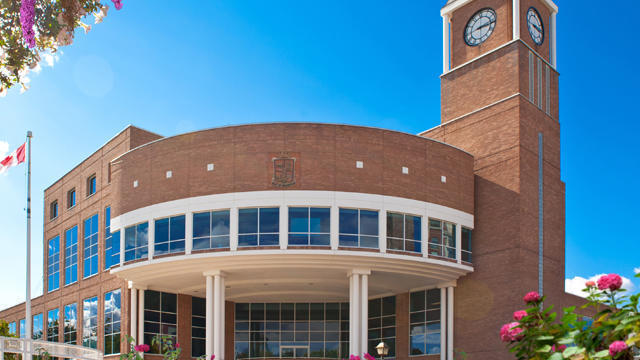Here’s Who’s Who on Brampton’s New City Council
Published October 23, 2018 at 6:33 pm

Well it looks like Brampton may be heading into some uncharted waters.
Well it looks like Brampton may be heading into some uncharted waters.
Last night’s municipal election saw a veteran Brampton politician with a track record dating back decades defeated, after her first term as mayor, to a man whom months ago was considered a pariah clouded in scandal with very little hope of mounting a successful political comeback.
The latter individual is now mayor-elect of Canada’s ninth largest city.
In addition, the rest of city council is finally going to see a bit of diversity around the chambers as four new councillors were elected.
Here is a quick rundown of the incoming new Brampton City Council:
Mayor
Photo courtesy of Brown’s Facebook page
Obviously, the biggest news of the night was Patrick Brown becoming the new Brampton mayor.
The former PC leader took home 46,894 votes, or 44 per cent, while incumbent mayor Linda Jeffrey followed with 42,993, or just under 41 per cent, of the vote. Brown won with a margin of 3,900.
Former MP Bal Gosal was in third place with 5,319 votes, followed by Regional Coun. John Sprovieri with 5,028 votes, Wesley Jackson with 2,442 votes, Vinod Mahesan with 1,905 votes and Mansoor Ameersulthan with 972 votes.
Wards 1 and 5
Photo courtesy of Paul Vicente’s Facebook page
In what may be a rare occurrence in Brampton municipal politics, two candidates in the same ward ran on a slate ‘as a team’ and were elected, which could be the closest thing to a ‘party’ at the municipal level.
Paul Vicente (left on photo) was elected as regional councillor with 43 per cent of the vote, some 12 points ahead of his closest challenger, business owner Mario Russo, who scored 31 per cent. Meanwhile, Rowena Santos was elected as city councillor with just over 41 per cent in a crowded field of 11 other candidates.
Santos and Vicente announced when they launched their campaigns they would be running “as a team” in the election. “Brampton has outgrown its small town status. We need councillors who will actively engage with constituents and take swift action to move our city forward. Let’s make Brampton a place where people can live, work, and play,” Santos said.
Vicente also founded a citizens group alongside Santos called Stand Up for Brampton. Both jointly campaigned together, even with their election signs basically installed as one and were clearly seen as being backed by Jeffrey. Now that this “team” has been elected to serve Wards 1 and 5, how they will work with Mayor-elect Brown remains to be seen.
Wards 2 and 6
Reelected regional councillor Michael Palleschi (left) and city councillor Doug Whillans (right)
In the north and western part of Brampton, there was no change as both incumbent councillors Doug Whillans and Michael Palleschi were reelected, despite facing some strong opposition.
Whillans won 5,968 votes (or 29 per cent) while the rest were split amongst eight other candidates. Three other candidates, Jermaine Chambers (a banker and former PC party nomination candidate), Jim McDowell (who was endorsed by labour unions) and Joe Sidhu polled within the teens.
As for Palleschi, while there was a last minute accusation that he made racist comments about the Indo-Canadian community, he was reelected with 7,340 votes (35 per cent). His closest competitors were lawyer Gurpreet Bains who polled 5,971 votes (28 per cent) and Everton Dwight Campbell who polled 2,726 votes (13 per cent).
The numbers for both councillors were remarkably similar to what they garnered in 2014. Palleschi also backed Brown in the mayoral race.
Wards 3 and 4
Keeping up with that trend, Wards 3 and 4 opted to return their incumbents to office: Jeff Bowman (left) for city council and Martin Medeiros (right) at regional council, despite both facing two strong challengers.
Bowman was opposed by longtime community activist Harpreet Singh Hansra, who also works at William Osler Health System. But despite a really strong campaign and Linda Jeffrey’s endorsement, Bowman improved on his initial 2014 showing with 9,950 votes (52 per cent). Hansra managed to snag 4,361 votes (23 per cent).
In the regional council race, it was a slugfest as Medeiros tangled with former regional councillor John Sanderson, who gave up his seat to run for mayor in 2014. Medeiros ended up winning the race with 7,551 votes (39 per cent) over Sanderson’s 6,175 votes (32 per cent).
While Bowman opposed Mayor Jeffrey on a number of key issues, Medeiros was a close ally of the outgoing mayor. This will prove to be interesting dynamics to watch as the regional councillor will have to deal with Patrick Brown.
Wards 7 and 8
In these wards, the same attempt by two council candidates to run as “a slate” backfired, but on the bright side a small slice of history was made.
Charmaine Williams (left), a small business owner, will become the first black woman to sit on Brampton City Council. She won the city council seat after incumbent Pat Fortini (right) ran for regional council upon the retirement of Gael Miles, who had been in office for 30 years.
Williams won her race with 26 per cent, beating out Martin Singh (who won 22 per cent) and seven other candidates. Singh, a former federal NDP candidate, ran as an ally of Fortini. One of Williams’ more interesting promises was getting guns off the streets by proposing a gun amnesty and gun buyback program, which resonates in a city where gun violence became a series issue.
Meanwhile, Fortini had an easier time securing a spot on Peel Regional Council, winning 10,299 votes (53 per cent), beating Bruce Marshall (a former radio host), Ajay Tandon and 20 year old Cody Vatcher.
Wards 9 and 10
Newly elected city councillor Harkirat Singh (left) and newly elected regional councillor Gurpreet Dhillon (right)
And finally in another nod to Brampton’s growing diversity, the Sikh representation around Brampton council has now doubled from one to two.
City councillor Gurpreet Dhillon was elected as a regional councillor and Peel school trustee Harkirat Singh took Dhillon’s spot as city councillor.
Singh was elected with 43 per cent of the vote in a field of seven candidates, while Dhillon moved onto regional council with 55 per cent of the vote. Dhillon defeated not only fellow candidate Michelle Shaw but Vicky Dhillon, the former city councillor whom Gurpreet ousted from office in 2014.
What does this mean for Brampton going forward?
In earlier analysis, I opined on what would happen if either mayoral candidate gets elected, but the majority of councillors favoured the other nominee for mayor. If you look around the incoming council Brown will now chair, most of them backed Linda Jeffrey, or were on the ‘progressive’ side of the political spectrum.
Only Palleschi, Bowman or Whillans could be seen to be on the side of Brown.
If Brown wants to do things like freeze municipal property taxes, bring jobs to Brampton and do all the things he promised during the campaign, he’ll need to cobble together a working majority of six councillors to side with him on issues. He may need more in order to not be perceived as “only getting what’s necessary” to get things done.
The other consideration is that, with all the baggage of prior sexual assault allegations, political scandals left over from his PC party leader days and the accusations that he ‘overspent’ his MPP budget upon leaving Queen’s Park, some may see Brown as just a ‘magnet for trouble’ and his mayoralty not lasting beyond 2022.
Should that happen, expect certain councillors like Medeiros, Dhillon and Palleschi thinking about their own future political ambitions.
What did you think of last night’s election results?
INsauga's Editorial Standards and Policies

